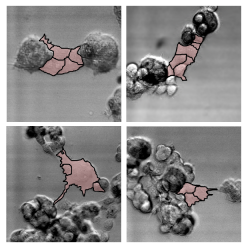Cancer is a mysterious disease for many reasons. Chief among the unknowns are how and why tumors form.
Two University of Iowa studies offer key insights by recording in real time, and in
The team discovered that cancerous cells actively recruit healthy cells into tumors by extending a cable of sorts to grab their
«It’s not like things sticking to each other," said David Soll, biology professor at the UI and corresponding author on the paper, published in the American Journal of Cancer Research. «It’s that these cells go out and actively recruit. It’s complicated stuff, and it’s not passive. No one had a clue that there were specialized cells in this process, and that it’s a small number that pulls all the rest in.»
The findings could lead to a more precise identification of tumorigenic cells (those that form tumors) and testing which antibodies would be best equipped to eliminate them. Soll’s Monoclonal Antibody Research Institute and the Developmental Studies Hybridoma Bank, created by the National Institutes of Health as a national resource, directed by Soll and housed at the UI, together contain one of the world’s largest collections of antibodies that could be used for the
 In a paper published last spring in the journal PLOS One, Soll’s team showed that only cancerous cells (from a variety of cancers, including lung, skin, and aggressive brain tumors known as glioblastomas) engaged in tumor formation by actively soliciting other cells. Like
In a paper published last spring in the journal PLOS One, Soll’s team showed that only cancerous cells (from a variety of cancers, including lung, skin, and aggressive brain tumors known as glioblastomas) engaged in tumor formation by actively soliciting other cells. Like
«There’s nothing but tumorigenic cells in the bridge (between cells)," Soll said, «and that’s the discovery. The tumorigenic cells know what they’re doing. They make tumors.»
The question is how these cells know what to do. Soll hypothesizes they’re reaching back to a primitive past, when these cells were programmed to form embryos. If true, perhaps the cancerous
Think of a Death Star that’s built up enough defenses to ward off repeated attacks. Or, less figuratively, how bacteria can conspire to create an impenetrable film on surfaces, from orthopedic implants to catheters.
«There must be a reason," Soll said. «You might want one big tumor capable of producing the tissue it needs to form a
In the AJCR paper, the researchers compared the actions of human breast tissue cells (
Also, in all instances, regardless of the ratio of
«The results here extend our original observation that tumorigenic cell lines and fresh tumor cells possess the unique capacity to undergo coalescence through the active formation of cellular cables," the authors write.
The finding lends more weight to the idea that tumors are created concurrently, in multiple locations, by individual clusters of cells that employ the
Soll’s team also discovered that the
Contributing authors, all from the University of Iowa, include Joseph Ambrose, Michelle Livitz, Deborah Wessels, Spencer Kuhl, Daniel Lusche, and Edward Voss. Amanda Scherer, now at the University of Michigan, also contributed to the research while at the UI.
The Developmental Studies Hybridoma Bank funded the study.
Source: http://now.uiowa.edu/2016/01/cancer-riddle-solved

